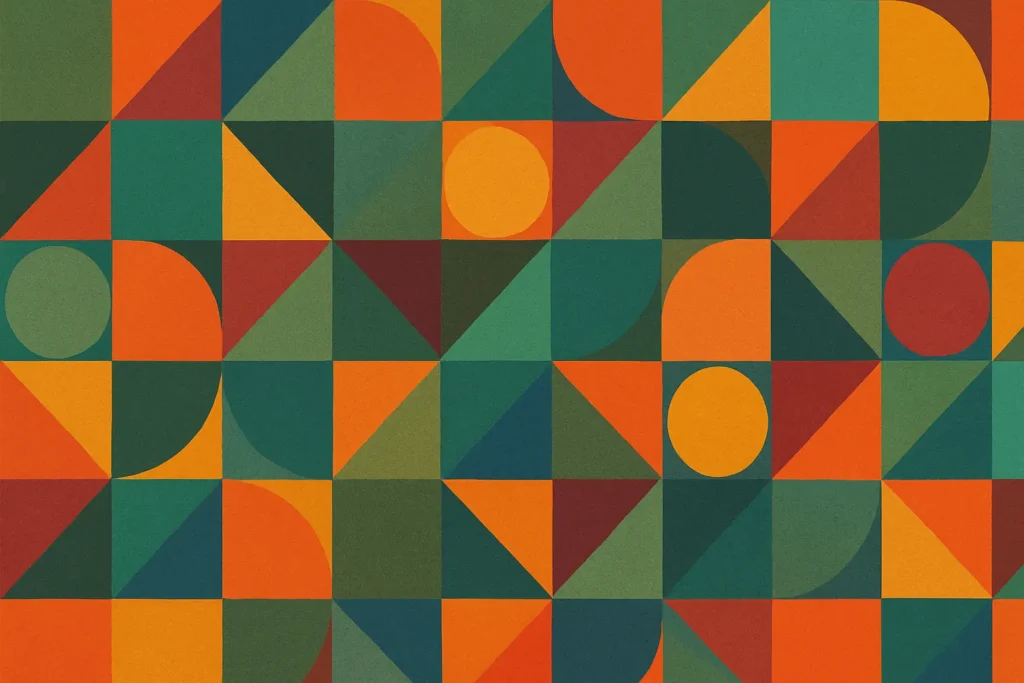You know that tiny pause when you’re doom-scrolling and your thumb almost stops? That half-breath is all a design gets. If the page can’t explain “what this is, why it matters, and what to do next” in about five seconds, we’re gone. No dramatic monologue. No second chance.
This isn’t about being flashy. It’s about hierarchy—what your eyes notice first, second, and third. Below is a friendly, in-the-trenches guide to building that hierarchy on purpose so your work survives the five-second test.
What really happens in five seconds
Five seconds is plenty of time for the brain to do three things:
- Get the gist
Before you “read,” you glance. We grab the big shapes, the brightest contrast, the human faces, the largest words. That creates a snap judgment: “Skincare brand? Finance app? Furniture sale?” - Pick a path
Our eyes look for a trail of crumbs: headline → image → button → reassurance. If the trail is broken—too many equally loud elements or nothing clearly louder—attention scatters. - Decide to stay or bail
Micro-decisions kick in: Do I trust this? Is it for me? Is the next step obvious? If the brain has to dig for those answers, it conserves energy by leaving.
Design’s job is to make those three moves absurdly easy.
A quick definition of visual hierarchy (and what actually moves the needle)
Hierarchy is the intentional order of attention created with:
- Size & weight: Bigger isn’t always better, but clearly larger almost always wins first glance.
- Contrast: Light vs dark, filled vs outline, sharp vs soft. (Contrast is hierarchy’s horsepower.)
- Position: Where elements sit in the scan path—top-left or center on desktop; dead-center or top on mobile.
- Whitespace: Empty space signals importance by isolation. If everything is close, nothing feels important.
- Color: Use color as a spotlight, not confetti. One accent color for actions beats five “brand” colors fighting.
- Grouping (proximity): Things near each other are perceived as related. Group ruthlessly.
- Alignment: Align edges so the eye can glide. Misalignments create accidental “speed bumps.”
- Imagery: Photos with clear subject, eye direction, or motion cues pull gaze along your intended path.
- Motion: Subtle movement (think micro-interactions) can nudge attention—but only when used sparingly.
The “3W” clarity check for first glance
In five seconds, a user should answer:
- What is this? (Category/product)
- Why should I care? (Benefit/edge)
- What next? (Primary action)
If your top section can’t deliver those three, your hierarchy is off. Tape these on your monitor.
Classic scan patterns (and when not to trust them)
- F-pattern: Content-heavy pages. Users skim left edges and the first lines. Great for blogs and docs.
- Z-pattern: Simple landing pages. Eyes sweep left→right on the top bar, then diagonally to the CTA.
- Layer-cake: Chunked headings with short blurbs; users hop from heading to heading.
These are patterns, not laws. Real people will do weird things on cramped mobiles, super-wide monitors, or right-to-left scripts. Use the patterns as starting scaffolding, not handcuffs.
Build your hierarchy in this order (fast, practical)
1) Write the headline last (yes, last)
Design your layout first; then write a headline that fits the space and says the thing. Make it pass the squint test: zoom out to 50% and squint—can you still tell what’s being offered? If not, it’s fluff.
Formula you can steal:
- [Audience] + [Outcome] in [Time/Constraint]
- Specific proof > adjectives
Example: “Freelancers, see next month’s cashflow in 60 seconds. No spreadsheets.”
2) Pick one accent color, one action
Primary action = one color. Secondary actions = outline or subdued. If your navbar, badges, and CTAs are all the same bright hue, nothing is primary. Keep the spotlight pure.
3) Reduce visual noise by 30–50%
- Shrink or remove decorative lines and drop shadows that don’t group or separate anything.
- Limit type sizes to three levels (headline, subhead, body) and weights to two (bold, regular).
- Use one decorative font (if any) and one workhorse sans/serif for everything else.
4) Group like a librarian
Each section should answer a single question. Title + 1–2 sentences + one action. If a bullet doesn’t help answer that section’s question, kick it out or move it.
5) Give your CTA a quiet stage
Surround the main button with generous whitespace. Nearby reassurance (e.g., “No card needed,” “3-min setup”) reduces hesitation. That’s hierarchy, not just copywriting.
The 5-second test you can run today (no fancy tools)
Prep (5 mins):
- Take a clean screenshot of your hero section (or key screen).
- Make a grayscale version (turn saturation to 0).
- Crop to what loads first on mobile.
Test (10 mins):
- Show it to 5 people (colleagues/friends). Each person sees it for exactly five seconds.
- Hide it and ask three questions:
- “What was it about?”
- “What do you remember?”
- “What would you click next?”
- “What was it about?”
- Score each answer quickly:
- Clarity (0–2): 0 = wrong, 1 = vague (“finance app?”), 2 = precise (“cashflow for freelancers”).
- Priority (0–2): Did they mention the main benefit or just a random detail?
- Action (0–2): Could they name the next step?
- Clarity (0–2): 0 = wrong, 1 = vague (“finance app?”), 2 = precise (“cashflow for freelancers”).
Aim for ≥5/6 on average before you ship. If scores are low, fix one hierarchy lever at a time (headline, CTA contrast, grouping) and retest.
Bonus micro-tests:
- Squint test: Blur the design; can you still spot the headline and CTA?
- One-thumb test (mobile): Can you reach the primary action without finger yoga?
- Grayscale test: If color dies, does the layout still tell a story?
Mini before/after: a D2C hero that actually converts
Before
- Headline: “Glow Naturally.”
- Subhead: “Our botanicals are crafted with love.”
- Background: Full-bleed lifestyle photo with busy kitchen.
- Two CTAs: “Shop Now” and “Learn More,” same color.
- Three floating badges: “Vegan,” “New,” “Trending.”
What happens in 5 seconds?
Users see “pretty skincare,” get no concrete benefit, and have two equally loud choices. Many bounce.
After
- Headline: “Clear skin in 14 days—backed by 3,142 reviews.”
- Subhead: “Clinically-tested vitamin C serum for acne-prone skin.”
- Image: Tight bottle shot with subtle face crop looking toward the CTA.
- One primary CTA (accent color): “Get My Serum.”
- Reassurance line under CTA: “Free shipping • Pay on delivery.”
- Badges relocated under the fold in a quiet row.
Result in 5 seconds:
Gist (skincare), benefit (clear skin in 14 days, social proof), action (Get My Serum). The eye lands on headline → bottle → CTA in a clean loop.
The anatomy of a high-hierarchy hero
- Headline (H1, 3–7 words if possible): concrete outcome or specific value.
- Subhead (one line): who it’s for + how it works.
- Primary visual: subject points to the CTA or headline; avoid chaotic backgrounds.
- Primary CTA: verb-first (“Start free trial,” “Calculate EMI”).
- Reassurance: tiny line that melts the main objection.
- Secondary link: low-contrast, for the curious (“See how it works”).
If any piece competes with the headline or the CTA, it’s not a supporting actor—it’s a distraction.
Don’t let typography sabotage you
- One rhythm, three sizes: e.g., 40/24/16 (desktop), 28/18/15 (mobile). Keep line-height generous (1.3–1.6).
- Use numbers: “Save ₹1,200/month” beats “Save big.” Numbers are visual anchors.
- Contrast with restraint: A single bold phrase can carry the benefit. Bold everything and you bold nothing.
- Devanagari + Latin pairing tip (for Indian brands): Match x-height with matra height and keep weight harmony. If Latin is humanist, choose a warm, readable Devanagari; avoid ultra-condensed pairings that create uneven rhythm.
Color that guides (not decorates)
- Accent = action: Only CTAs and links get the accent. Badges and chips? Use neutrals until the user hovers.
- Semantic meaning: Save red for errors or destructive actions; don’t burn it on decorative tags.
- Contrast ratios: If body text struggles on brand backgrounds, the brand color belongs in small doses, not behind paragraphs.
Imagery with intent
- Face direction: Humans look where other humans look. Turn the model slightly toward your headline or CTA.
- Show outcome, not just product: A “before/after” graph, a filled shopping cart, a dashboard with one key metric highlighted.
- Kill filler: Stock photos with handshakes or random city skylines create noise without meaning.
Common hierarchy killers (and quick fixes)
- Everything is shouting: Too many saturated colors, too many bolds. → Choose one accent, demote the rest.
- Carousel heroes: Users see slide 1 for two seconds; slides 2–5 don’t exist. → Pick the best slide; make it the page.
- Button soup: “Contact,” “Buy,” “Subscribe,” “Chat,” “Share,” stacked together. → One primary, one secondary.
- Decorative separators: Lines and boxes everywhere. → Use spacing and alignment; draw fewer boxes.
- Equal-weight cards: Ten identical product cards give no priority. → Feature one “best seller” with scale + badge; keep the rest calm.
A 10-minute hierarchy tune-up (hands-on)
- Set one goal: What single action should a new visitor take?
- Rename your headline to the clearest outcome you can promise. Cut cleverness.
- Mute your palette so only CTAs keep the bright accent.
- Group content into three blocks: value, proof, action. Everything else moves down or out.
- Add one line of reassurance right under the primary button.
- Run the five-second test with two friends. Make one fix. Repeat.
You’ll be shocked how far this gets you.
Five-second checklist (print this)
- Can a stranger say what this is—in one sentence?
- Do headline and CTA survive the squint/grayscale test?
- Is there one accent color tied to one primary action?
- Does the hero show outcome, not just product?
- Are sections grouped by a single question each?
- Did we remove 30% of decorative noise?
- Is the next step crystal clear and within one thumb on mobile?
If you can tick these, you’re already in the top tier.
For apps and dashboards (same rule, different surface)
- Empty states: Teach with one sentence + one action. Empty states are your best five seconds for onboarding.
- Settings screens: Promote the 1–2 high-impact toggles; bury advanced options behind “Advanced.”
- Notifications: Title = action (“Payment failed”), line 2 = fix (“Update card”). Don’t make users decode.
Accessibility is hierarchy (not a chore)
- Real contrast makes reading effortless.
- Don’t rely on color alone; pair with icons/labels.
- Respect reduced motion preferences; movement should never be the only way to notice something.
Good hierarchy helps everyone—especially users with low vision or cognitive load.
Measure if your five seconds worked
No need to build a lab. Watch for:
- Time to first interaction (how quickly the CTA gets clicked).
- Scroll depth (does the hero make people want more?).
- Top clicked elements (are people clicking the intended action?).
- Bounce rate on landing pages (a blunt instrument, but useful paired with the others).
When these move in the right direction, your hierarchy is doing its job.
Wrap-up: Design for the pause
Those first five seconds aren’t a trap; they’re a gift. They force clarity. If your design can deliver the 3W—what it is, why it matters, what to do next—you earn the next five seconds, and the five after that.
So, run the quick tests. Strip the noise. Give your CTA a quiet stage. And write headlines that sound like a human explaining something useful to another human.
If you want, share a screenshot of your hero or a key screen, and I’ll give you a five-second read of what stands out first and what to fix next.

